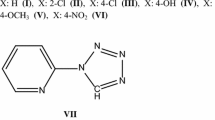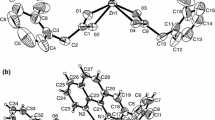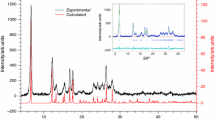Abstract
Thermal decomposition studies of 2,3,5-triphenyl tetrazolium halochromates have been carried out upto 1000°C at a linear heating rate of 10 deg·min−1. The complexes undergo two stage decomposition. First one corresponds to the redox decomposition of the complex along with the loss of a phenyl halide molecule and 3/2 mol of oxygen. While, the second step corresponds to the oxidation of the formazan type structure formed in the first step. The first step decomposition follows diffusion controlled reaction mechanism in a sphere governed by the equationg(α)=[1−(1−α)1/3]2. Activation energy and pre-exponential factors have been determined by Coats-Redfern model and Dixit-Ray model. Activation energy decreases as the electronegativity of the halide ion decreases.
Zusammenfassung
Bei einer linearen Aufheizgeschwindigkeit von 10 deg·min−1 wurden bis zu Temperaturen von 1000°C thermische Zersetzungsstudien an 2,3,5-Triphenyltetrazolium-halochromaten durchgeführt. Die Komplexe durchlaufen zwei Zersetzungsstufen. Die erste entspricht der Redoxzersetzung des Komplexes unter Verlust eines Phenylhalogenid- moleküles und von 3/2 mol Sauerstoff. Der zweite Schritt entspricht der Oxidation der beim ersten Schritt entstandenen Struktur vom Formazan-Typ. Die zum ersten Schritt gehörende Zersetzung verläuft nach einem diffusionskontrollierten Reaktionsmechanismus innerhalb einer Kugel entsprechend der Gleichung g(α)=[1− (1−α)1/3]2]. Die Ativerungsenergie und die präexponentiellen Faktonen wurden anhand des Coats-Redfern’schen und des Dixit-Ray’schen Modelles bestimmt. Die Aktivierungsenergie sinkt mit steigender Elektronegativität des Halogenidiones.
Similar content being viewed by others
References
K. B. Wiberg, Oxidation in Organic Chemistry, Part-A, Academic Press 1965, p. 965.
J. K. Beattle and G. P. Height, Jr., Prog. Inorg. Chem., 17 (1972) 93.
F. A. Luzzio and F. S. Guziec, Jr., Org. Prep. Proceed. Int., 20 (1988) 533.
C. L. Rollington, The chemistry of Cr, Mo and W, Pergamon Texts in Inorganic Chemistry, Vol. 21, Pergamon Press, Oxford 1975, p. 695.
M. N. Sastri and T. S. R. P. Rao, J. Inorg. Nucl. Chem., 30 (1968) 1727.
H. Stammerich, O. Sala and K. Kawai, Spectrochim. Acta, 17 (1961) 226.
M. J. Reisfeld, L. B. Asprey and N. A. Matwiyoff, Spectrochim. Acta, 27 (1971) 765.
I. I. Kukushina, E. N. Yurchenko, M. I. Ermakova and N. I. Latosh, Zh. Fiz. Chem., 46 (1972) 176.
G. Horváth and G. Jerkovich, Kém. Közl., 46 (1972) 499.
A. W. Coats and J. P. Redfern, Nature (London), 201 (1964) 68.
S. K. Dixit and H. S. Ray, Thermochim. Acta, 54 (1982) 245.
Author information
Authors and Affiliations
Rights and permissions
About this article
Cite this article
Patnaik, U.R., Prasad, T.P. & Muralidhar, J. Thermal decomposition of 2,3,5-triphenyl tetrazolium halochromate complexes. Journal of Thermal Analysis 45, 1463–1470 (1995). https://doi.org/10.1007/BF02547439
Received:
Revised:
Issue Date:
DOI: https://doi.org/10.1007/BF02547439




